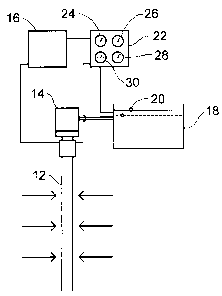Some of the information on this Web page has been provided by external sources. The Government of Canada is not responsible for the accuracy, reliability or currency of the information supplied by external sources. Users wishing to rely upon this information should consult directly with the source of the information. Content provided by external sources is not subject to official languages, privacy and accessibility requirements.
Any discrepancies in the text and image of the Claims and Abstract are due to differing posting times. Text of the Claims and Abstract are posted:
| (12) Patent: | (11) CA 2512437 |
|---|---|
| (54) English Title: | METHOD OF CONTROLLING A WELL |
| (54) French Title: | METHODE DE CONTROLE D'UN PUITS |
| Status: | Granted and Issued |
| (51) International Patent Classification (IPC): |
|
|---|---|
| (72) Inventors : |
|
| (73) Owners : |
|
| (71) Applicants : |
|
| (74) Agent: | NATHAN V. WOODRUFFWOODRUFF, NATHAN V. |
| (74) Associate agent: | |
| (45) Issued: | 2013-09-03 |
| (22) Filed Date: | 2005-07-04 |
| (41) Open to Public Inspection: | 2007-01-04 |
| Examination requested: | 2010-07-02 |
| Availability of licence: | N/A |
| Dedicated to the Public: | N/A |
| (25) Language of filing: | English |
| Patent Cooperation Treaty (PCT): | No |
|---|
| (30) Application Priority Data: | None |
|---|
A method and apparatus for predicting and controlling secondary kicks, while dealing with a primary kick experienced when drilling an oil and gas well. The method includes a step of determining whether a different pressure per cubic meter of mud pit volume has been caused by a secondary kick by subtracting shut in drill pipe pressure (SIDPP) from shut in casing pressure (SICP) and dividing the derived sum by a kick volume in KPa per cubic meter from the primary kick. A further step is then taken of increasing casing pressure until casing pressure equals pit gain times (X) rate of change in casing pressure per cubic meter of pit gain plus (+) SIDPP.
Une méthode et un dispositif pour prédire et contrôler des venues secondaires, tout en traitant la venue primaire ressentie lors du forage d'un puits de pétrole et de gaz. La méthode comprend une étape pour déterminer si une différente pression par mètre cubique de volume de bassin à boue a été causée par une venue secondaire en soustrayant la pression en tête de tiges puits fermé (PTTPF) de la pression en tête de l'espace annulaire puits fermé (PTEAPF) et en divisant la somme dérivée par un volume de venue en kPa par mètre cube de la venue primaire. Une autre étape est alors prise pour augmenter la pression de cuvelage jusqu'à ce qu'elle soit équivalente au gain dans le bassin de boue multiplié (X) par le taux de changement dans la pression de cuvelage par mètre cube de gain dans le bassin de boue additionné (+) au PTTPF.
Note: Claims are shown in the official language in which they were submitted.
Note: Descriptions are shown in the official language in which they were submitted.

2024-08-01:As part of the Next Generation Patents (NGP) transition, the Canadian Patents Database (CPD) now contains a more detailed Event History, which replicates the Event Log of our new back-office solution.
Please note that "Inactive:" events refers to events no longer in use in our new back-office solution.
For a clearer understanding of the status of the application/patent presented on this page, the site Disclaimer , as well as the definitions for Patent , Event History , Maintenance Fee and Payment History should be consulted.
| Description | Date |
|---|---|
| Common Representative Appointed | 2019-10-30 |
| Common Representative Appointed | 2019-10-30 |
| Maintenance Request Received | 2019-10-21 |
| Letter Sent | 2019-07-04 |
| Inactive: Office letter | 2018-07-09 |
| Maintenance Request Received | 2018-07-04 |
| Maintenance Request Received | 2018-07-03 |
| Maintenance Request Received | 2014-07-04 |
| Grant by Issuance | 2013-09-03 |
| Inactive: Cover page published | 2013-09-02 |
| Pre-grant | 2013-06-19 |
| Inactive: Final fee received | 2013-06-19 |
| Notice of Allowance is Issued | 2012-12-19 |
| Letter Sent | 2012-12-19 |
| Notice of Allowance is Issued | 2012-12-19 |
| Inactive: Approved for allowance (AFA) | 2012-12-11 |
| Amendment Received - Voluntary Amendment | 2012-10-10 |
| Inactive: S.30(2) Rules - Examiner requisition | 2012-04-16 |
| Inactive: Office letter | 2011-05-25 |
| Inactive: Office letter | 2011-05-25 |
| Amendment Received - Voluntary Amendment | 2010-10-14 |
| Letter Sent | 2010-07-15 |
| Request for Examination Received | 2010-07-02 |
| Request for Examination Requirements Determined Compliant | 2010-07-02 |
| All Requirements for Examination Determined Compliant | 2010-07-02 |
| Small Entity Declaration Determined Compliant | 2008-06-23 |
| Small Entity Declaration Request Received | 2008-06-23 |
| Application Published (Open to Public Inspection) | 2007-01-04 |
| Inactive: Cover page published | 2007-01-03 |
| Inactive: IPC assigned | 2005-09-20 |
| Inactive: First IPC assigned | 2005-09-20 |
| Application Received - Regular National | 2005-08-26 |
| Filing Requirements Determined Compliant | 2005-08-26 |
| Inactive: Filing certificate - No RFE (English) | 2005-08-26 |
| Small Entity Declaration Determined Compliant | 2005-07-04 |
There is no abandonment history.
The last payment was received on 2013-06-20
Note : If the full payment has not been received on or before the date indicated, a further fee may be required which may be one of the following
Please refer to the CIPO Patent Fees web page to see all current fee amounts.
Note: Records showing the ownership history in alphabetical order.
| Current Owners on Record |
|---|
| JAVED SHAH |
| Past Owners on Record |
|---|
| None |